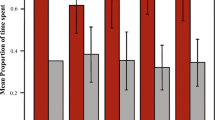Abstract
We used interdemic variation in the tendency to form mixed-species groups to examine the costs and benefits of association among the primates of Kibale National Park, Uganda. A year-long survey of six sites revealed that the amount of time that the five common diurnal primates [red colobus (Procolobus tephrosceles), black-and-white colobus (Colobus guereza), redtail monkeys (Cercopithecus ascanius), blue monkeys (Cercopithecus mitis), and grey-cheeked mangabeys (Lophocebus albigena)] spent in mixed-species groups varied dramatically among sites. In many cases, the proportion of time that species associated was positively related to their densities. By using detailed behavioral observations of redtail monkeys and red colobus made over 4 years (2660 h) at four sites, we were able to reject the null hypothesis that associations occur by chance for only one of four sites. However, a correlative approach exploring the costs and benefits of association suggests that ecological variables do influence association patterns. We found that redtail monkeys and red colobus overlapped in diet (19.2% of their foraging effort) and traveled further when in mixed-species groups than when alone. Having demonstrated this, we examined the applicability of the ecological constraints model for predicting the proportion of the time spent in mixed-species groups based on food availability. For this analysis we concentrated on red colobus from the site with 35 months of observation and demonstrated that their tendency to be in mixed- species groups was related to food availability. We used two methods to examine if mixed-species associations function to decrease predation risk. First, chimpanzees are known to prey heavily on red colobus, but rarely kill other primates. The time red colobus spent in mixed-species groups was correlated to chimpanzee density, but it was not for the other monkey species, suggesting that mixed-species groups serve to decrease predation risk. Second, when red colobus groups contain more infants and are presumably at the greatest risk of predation, they form mixed-species groups most often. These results demonstrate that the costs and benefits of mixed-species associations vary dramatically over small spatial and temporal scales. If such variation is generally the case, then studies conducted at different locations or different times could easily highlight the importance of difference selective agents in favoring mixed-species associations.
Similar content being viewed by others
Author information
Authors and Affiliations
Additional information
Received: 10 February 1999 / Received in revised form: 16 September 1999 / Accepted: 2 October 1999
Rights and permissions
About this article
Cite this article
Chapman, C., Chapman, L. Interdemic variation in mixed-species association patterns: common diurnal primates of Kibale National Park, Uganda. Behav Ecol Sociobiol 47, 129–139 (2000). https://doi.org/10.1007/s002650050003
Issue Date:
DOI: https://doi.org/10.1007/s002650050003




